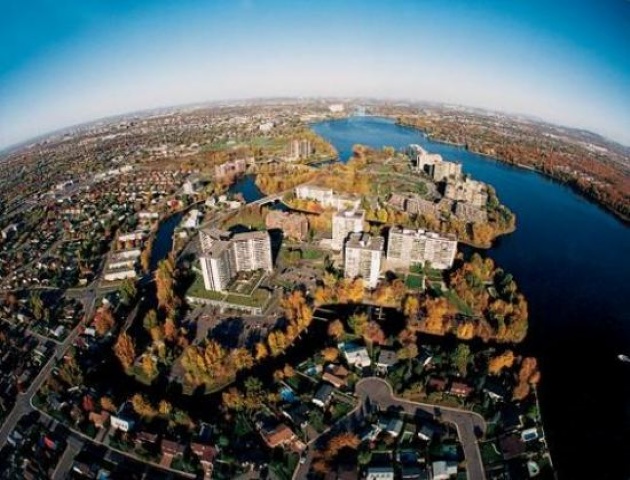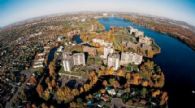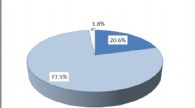A telling portrait of the English-speaking
community of Laval emerges when the findings regarding population size, age
structure and language use from the Census of Canada for 1996, 2001, 2006 and
2011 are compared.[1]
Laval’s
Growing Language Minority
In the period from 1996 to 2011, Laval’s
English-speaking population grew from 50,713 to 82,078 individuals. This
increased the community’s share of the total Laval population- both the
French-speaking majority and English-speaking minority combined- from 15.5<>percentage<> in
1996 to a robust 20.6<>percentage<> today.
The growth of 31,365 individuals between
1996 and 2011 represents an overall 61.8<>percentage<> increase, and notably, the greatest
jump in size among all of Quebec’s English-speaking regional communities for
the same period along with Nord-du-Quebec.
Equally interesting is the observation that
when all the regions of Quebec are compared, the English-speaking communities
with the greatest growth rates are located outside of Montreal. The Lanaudiere and
Outaouais regions follow Laval to claim the top positions for rate of growth
across the 1996-2011 census periods.
Population
Growth through the Lens of Age
Knowledge of the characteristics of a
growth trend in a regional territory such as Laval is essential to policy and
practice that contributes to the quality of life of its residents both today
and in the future.
When communities grow, they don’t all grow
the same way or for the same reasons. For example, population booms such as
those that have historically accompanied the discovery of gold or oil or other
major economic developments may not represent an increase in young families in
a given territory nor of older adults. They
are demographic transitions that may or may not have the stability to endure
over the long-term. Growth in some of the world’s largest populations is due almost
entirely to birth rates and cannot be explained by migration patterns or the
attraction of economic opportunity. Population growth due to high birth rates
and growth primarily through in-migration imply two different social realities
for those involved.
In the case of Laval when 1996 and 2011 are
compared, the distribution of individuals across age categories remains similar
despite an increase in overall numbers. This suggests the stability that
follows from a consistent pattern of growth over time. When age groups within
the English-speaking community are compared the largest group is 25-44 years cohort.
When majority and minority language groups are observed across the fifteen years,
there is a noted increase in the gap between English-speakers and
French-speakers in this age category. In 1996, 36.4<>percentage<> of English-speakers were
25-44 compared to 32.5<>percentage<> of French-speakers. In 2011, some 33.1<>percentage<> of English-speakers
were in this age group outweighing the 24.4<>percentage<> of Francophones by a greater
margin than observed fifteen years prior. Put
simply, the proportion of English-speakers 25-44 - often young workers and young
families - has jumped ahead relative to their majority neighbors in Laval.
Language use in Laval, 1996-2011
What do we learn from the census about
language use in the growing Laval population? The language being spoken most
often at home in Laval is French and the proportion of the population doing so
has remained around 80<>percentage<> since 1996. Interestingly, Laval differs from some
other regions in that there has been a growing diversity of languages being
spoken at home over the last fifteen years. The proportion of Laval residents
using English at home has increased and there has been an even greater increase
since 1996 among those using a non-official language as their home language.
Those who use English along with other languages at home have nearly doubled.
The level of English-French bilingualism in
2011 within the Laval Anglophone community is highest among those aged 15-44. The substantial and growing 25-44 age group
noted within the English-speaking community of Laval tends to be much more
bilingual than previous generations.
Adding
it all up
The English-speaking community of Laval has
grown in size in the last fifteen years and in 2011 the percentage of Laval Anglophones
aged 25-44 outweighed Francophones the same age. Not only has the
English-speaking community increased in size but the increase in non-official
language use suggests it has also grown in diversity.
It is not surprising to learn from a survey
of English-speaking Laval residents conducted in 2010 (CHSSN-CROP Survey of Community Vitality) that
access to services is a number one issue. Of specific concern was the
availability of services in English in health and social services, employment
and economic development, daycare/preschool and professional programs at the
CEGEP level. A substantial 83<>percentage<> of respondents indicated that local English
public schools were either extremely or very important to them. This sounds very
much like the voice of young working families with children and aging parents
looking for quality of life in their community and that of young adults seeking
certification and training during important working years.
Dr. Joanne Pocock is a sociologist who has devoted much of
her academic and research career to the study of Quebec’s English-speaking
minority communities. Her experience includes consultation, evaluation, policy
analysis and multi-method research techniques.
JPocock Research Consulting has been building knowledge for the federal
government and for the array of provincial institutions, networks and community
organizations that serve English-speaking Quebec for over ten years

 In The Latest Issue:Latest Issue:
In The Latest Issue:Latest Issue:
- A Bittersweet Farewell
- The new Laval Aquatic Co...
- The End of an Era:
Articles
Calendar
Virtual- ANNUAL TEACHER APPRECIATION CONTEST
- APPUI LAVAL
- ARTS & CULTURE
- CAMPS
- CAR GUIDE
- CCIL
- CENTENNIAL ACADEMY
- CHARITY FUNDRAISING
- CITYTV
- COSMODÔME
- COMMUNITY CONNECTIONS
- COVER STORY
- DINA DIMITRATOS
- ÉCOLE SUPÉRIEURE DE BALLET DU QUÉBEC
- EDITORIALS
- ÉDUCALOI
- EDUCATION
- EMPLOYMENT & ENTREPRENEURSHIP
- FÊTE DE LA FAMILLE
- FÊTE DU QUARTIER SAINT-BRUNO
- FAMILIES
- FESTIVAL LAVAL LAUGHS
- FÊTE DE QUARTIER VAL-DES-BRISES
- FINANCES
- GLI CUMBARE
- GROUPE RENO-EXPERT
- HEALTH & WELL-BEING
- 30 MINUTE HIT
- ANXIETY
- CHILDREN`S HEALTH & WELLNESS
- CLOSE AID
- DENTAL WELLNESS
- EXTREME EVOLUTION SPORTS CENTRE
- FONDATION CITÉ DE LA SANTÉ
- GENERAL
- HEARING HEALTH
- MESSAGES FROM THE HEALTH AGENCY OF CANADA
- MENTAL HEALTH
- SEXUALITY
- SOCIAL INTEGRATION
- SPECIAL NEEDS
- TEENS
- THE NUTRITION CORNER
- THE NUTRITION CORNER - RECIPES
- VACATION DESTINATION
- WOMEN'S FITNESS
- WOMEN'S HEALTH
- HILTON MONTREAL/LAVAL
- HOME & GARDEN
- INTERNATIONAL WOMEN'S DAY
- JAGUAR LAVAL
- LAVAL À VÉLO
- LAVAL FAMILIES TV SHOW
- LAVAL FAMILIES MAGAZINE CARES
- LAVAL URBAN IN NATURE
- LE PARCOURS DES HÉROS
- LES PETITS GOURMETS DANS MA COUR
- LEON'S FURNITURE
- LEONARDO DA VINCI CENTRE
- LFM PREMIERES
- LIFE BALANCE
- M.P. PROFILE
- MISS EDGAR'S AND MISS CRAMP'S SCHOOL
- MISSING CHILDREN'S NETWORK
- NETFOLIE
- NORTH STAR ACADEMY LAVAL
- OUTFRONT MEDIA
- PASSION SOCCER
- PARC DE LA RIVIÈRE-DES-MILLE-ÎLES
- PÂTISSERIE ST-MARTIN
- PIZZERIA LÌOLÀ
- PLACE BELL
- PORTRAITS OF YOUR MNA'S
- ROCKET DE LAVAL
- SACRED HEART SCHOOL
- SCOTIA BANK
- SHERATON LAVAL HOTEL
- SOCIÉTÉ ALZHEIMER LAVAL
- STATION 55
- STL
- SUBARU DE LAVAL
- TECHNOLOGY
- TEDXLAVAL
- TODAY`S LAURENTIANS AND LANAUDIÈRE
- TODAY`S LAVAL
- WARNER MUSIC
- THIS ISSUE
- MOST RECENT
Magazine
Fifteen years and Growing
Portrait of the English-speaking community of Laval
[1] Census data for
1996-2006 is drawn from Statistics Canada 20<>percentage<> sample and 2011 is drawn from
100<>percentage<> sample. The language concept used here is First Official language Spoken
(FOLS) which defines “English-=speaking” using three census questions;
knowledge of official languages, mother tongue, and home language.
Articles ~e 105,7 Rythme FM 4 chemins Annual Teacher Appreciation Contest Appui Laval Arts & Culture Ballet Eddy Toussaint Camps THIS ISSUE MORE...
CONTESTS Enter our contests
CONTESTS Enter our contests
CALENDAR
Events & Activities
COMMUNITY Posts Events
PUBLICATIONS Our Magazine Family Resource Directory
LFM BUSINESS NETWORK Learn more
COUPONS Click to save!
COMMUNITY Posts Events
PUBLICATIONS Our Magazine Family Resource Directory
LFM BUSINESS NETWORK Learn more
COUPONS Click to save!
SUBSCRIPTIONS
Subscribe to the magazine
Un-Subscribe
E-NEWSLETTER Subscribe to our E-newsletter Un-Subscribe
WRITE FOR US Guidelines & Submissions
POLLS Vote today!
E-NEWSLETTER Subscribe to our E-newsletter Un-Subscribe
WRITE FOR US Guidelines & Submissions
POLLS Vote today!
ADVERTISERS
How to & Media guide
Pay your LFM invoice
SUGGESTIONS Reader's Survey Suggest a Listing
LFM About Us Our Mission Giving Back Contact Us
SUGGESTIONS Reader's Survey Suggest a Listing
LFM About Us Our Mission Giving Back Contact Us
 PICK-UP LOCATIONS
Get a copy of LFM!
PICK-UP LOCATIONS
Get a copy of LFM!
TERMS & CONDITIONS Privacy | Terms
ISSN (ONLINE) 2291-1677
ISSN (PRINT) 2291-1677
Website by ZENxDESIGN




 BY:
BY: 
Tweet
Share